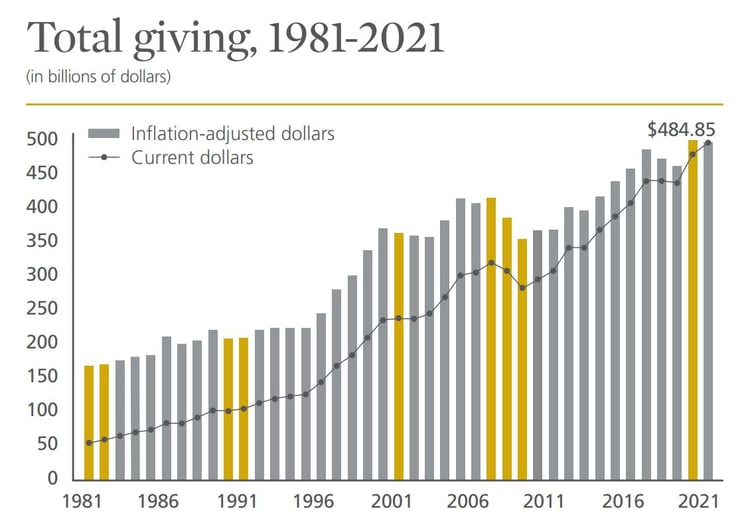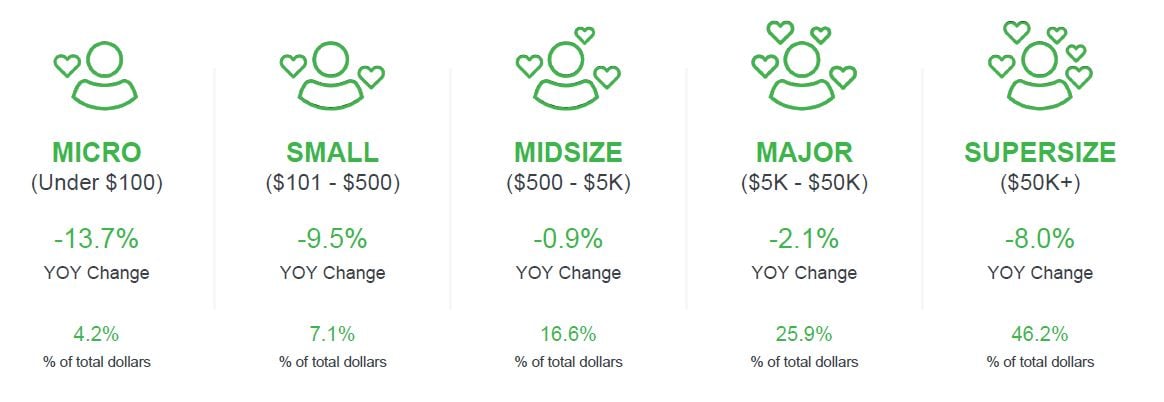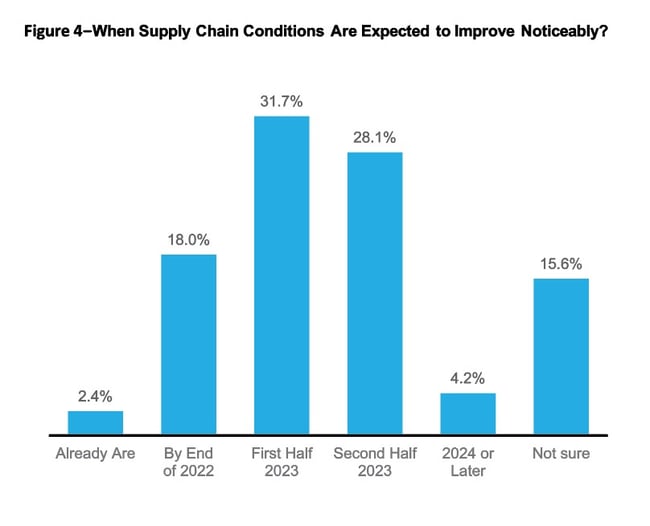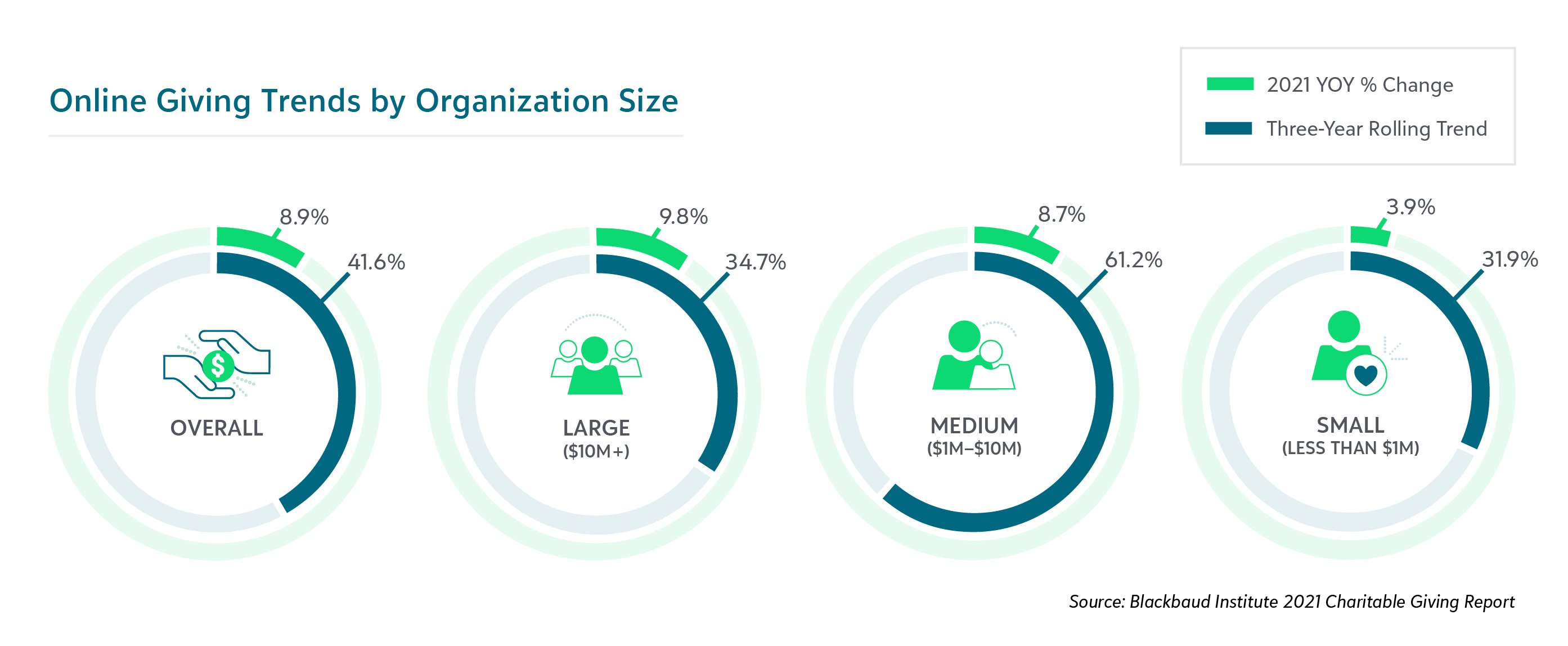We’re inching ever closer to year-end giving season, and nonprofit fundraisers and marketers across the U.S. have their heads down, planning intensely. But instead of focusing on the perfect image for that December appeal, let's step back—way back—and take a high-level view of where the industry stands in this moment.
As we close out 2022, RKD's experts have identified eight major trends that are affecting nonprofit fundraising:
1. Prior to COVID, we saw a narrowing donor pyramid.
- There was a two-decade trend of declining donors in the U.S.
- 49.6% of U.S. households made a charitable contribution in 2018, a drop of almost 17 percentage points from 2000 when 66.2% of American households gave charitable donations.
- Yet giving grew consistently during this time, thanks largely to major gifts, bequests and foundations.
- The annualized average rate of growth in total giving since 1981 is 5.6 percent.
- Giving by foundations (according to Giving USA):
- $41.7 billion in 2001 (10% of all giving)
- $71.3 billion in 2016 (15% of all giving)
 Source: Giving USA
Source: Giving USA
Conclusion: Put it all together, and we see fewer total donors with a growth in wealthier donors.
2. During COVID, we saw an elevated wave of charitable giving.
- The Fundraising Effectiveness Project reported an 11% growth in giving industrywide from 2019 to 2021. This growth was largely seen by nonprofits with a closer tie to the pandemic response.
- That meant more donors and revenue for many orgs, especially those in human services.
- Food banks saw a 623% increase in new donors during the first six months of 2020
- Younger donors also stepped up during the pandemic, especially in giving to human services. RKD’s client data shows a dramatic difference in donor demographics at food banks:
- In 2013-14, 12% of food bank donors were under age 50.
- In 2020-21, 22% of food bank donors were under age 50.
Conclusion: The question was whether these donors would behave like disaster donors or would this awaken a new wave of dedicated charity.
3. Today, giving is beginning to return to 2019-2020 levels.
- 2020 and 2021 brought a boom in nonprofit fundraising, exceeding normal annual increases. In the first quarter of 2022, donations receded slightly. In fact, donations are closer to 2019 levels, but revenue is closer to 2020 levels.
- There are three main reasons for the decline:
- The last 2 years have simply had unsustainable highs.
- A shift of giving to different nonprofits is occurring (as the crisis of COVID begins to wane).
- As we see with many new donors , there is a relatively low retention rate of this wave of new COVID donors.
Conclusion: It's difficult to judge in the moment, but this does not appear to be a fall off the cliff—it is a regression to the mean.
4. Declining response continues to be a challenge among smaller donors.
- According to the Fundraising Effectiveness Project (FEP), the number of donors industrywide had fallen back to 2019 levels by the end of 2021.
- Retention rates also decreased -7.9% from 2019 to 2021.
- Retention rates and revenue of $500+ donors have remained stable. This group accounts for 90.5% of total revenue.
- Overall retention rates have sat below 50% industrywide each year since 2012, according to annual FEP reports.

Source: Fundraising Effectiveness Project Q1 2022 Report
Conclusion: RKD Group commissioned a study to understand what donors expect in their relationship with NPOs. This research has shown that making donors feel valued and involved builds stronger relationships, which leads to larger gifts.
5. Inflation is leaving its mark on charitable giving.
- Individual giving grew 4.0% from 2020 to 2021, but it actually dropped -0.7% when inflation is factored in.
- Consumer prices (food, housing, energy, transportation) rose 13.3% from January 2021 to June 2022. That 13.3% adds up to $717 out of pocket each month for U.S. households.
- Inflation, of course, hits lower-income households the hardest, and we’re seeing that in a July 2022 study of our client data for 30 million donors.
- Giving from households under $30,000 in annual income have declined 49% in giving year over year.
Conclusion: The impact of inflation is real, but it very much depends on where you live. That variance is reflected in the charitable giving data across the U.S.
6. Supply chain challenges persist in direct mail.
- The last two years have brought a host of new challenges for printing and mailing:
- Printing Impressions expects the industry will not get better until late 2023 or early 2024.
 Source: Printing Impressions
Source: Printing Impressions
Conclusion: Start preparing earlier and extending your timelines and production schedules.
7. Yet direct mail remains an essential piece of fundraising.
- Direct mail is core to nonprofit fundraising for mature nonprofits—and the market is expected to continue to grow annually, even with the COVID-era winds tied to supply chain and increased costs.
- Direct mail provides an exceptionally strong ROI, and RKD research shows that nonprofit marketers rank it as highest among the tools in their arsenal:

- Direct mail's tangibility carries emotional weight and substance. According to the USPS:
- 55% of people say they "look forward" to seeing what’s in their mailbox.
- 56% of people find print-based marketing to be the most trustworthy type of marketing.
- 70% of people agree that direct mail feels more personal than digital methods.
- This bodes well for direct mail, especially when McKinsey shows 58% of employees having some level of work-from-home option.
Conclusion: Direct mail’s foundational strength and continued relevance in a more prominent work-from-home environment supports its staying power in nonprofit marketing.
8. The rapid rise of digital fundraising cannot be ignored.
- McKinsey estimates that the COVID pandemic accelerated digital adoption by three years. Just looking at customer interactions in North America reveals this to be true:
- 41% were digital in Dec. 2019
- 65% were digital by July 2020, just seven months later
- Nonprofits have seen incredible digital growth in recent years. According to Blackbaud, online giving increased by 42% from 2018-2021. In fact, 12% of all giving now happens online, up from 8.7% in 2019.
- This lines up with consumer behavior that shows 13.9% of U.S. sales are now happening online.

- Mobile giving also continues to grow rapidly. The percentage of online transactions on a mobile device tripled in seven years:
- 2014: 9%
- 2021: 28%
Conclusion: Start transforming your digital programs to adapt to these rapid changes. Get the most out of your digital platforms by building effective fundraising strategies that integrate with your direct mail programs.






Leave a comment: